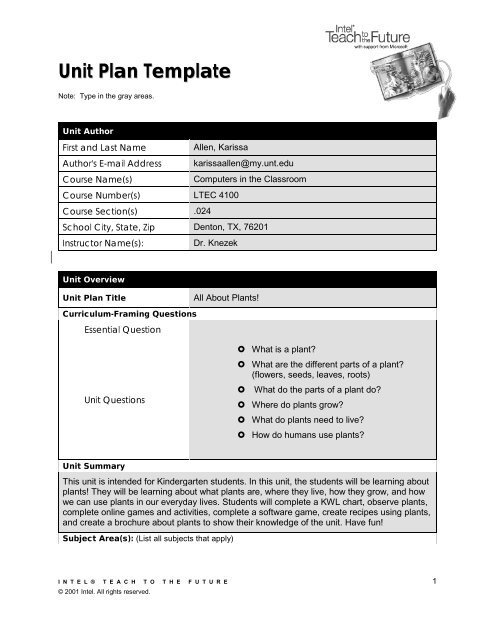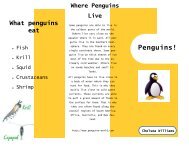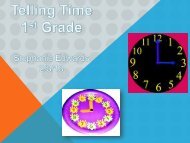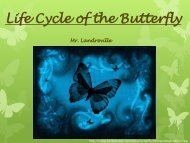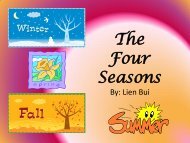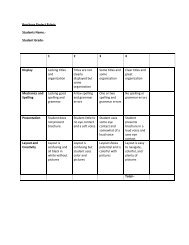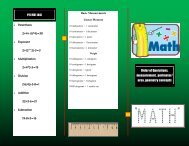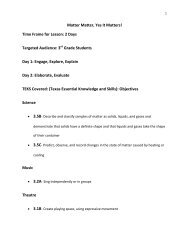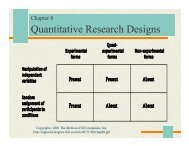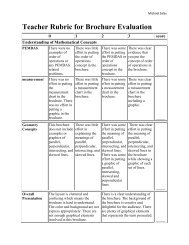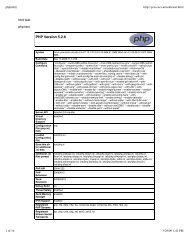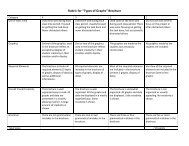Plants Unit Lesson Plan
Plants Unit Lesson Plan
Plants Unit Lesson Plan
- No tags were found...
Create successful ePaper yourself
Turn your PDF publications into a flip-book with our unique Google optimized e-Paper software.
<strong>Unit</strong> <strong>Plan</strong> TemplateNote: Type in the gray areas.<strong>Unit</strong> AuthorFirst and Last NameAuthor's E-mail AddressCourse Name(s)Allen, Karissakarissaallen@my.unt.eduComputers in the ClassroomCourse Number(s) LTEC 4100Course Section(s) .024School City, State, Zip Denton, TX, 76201Instructor Name(s):Dr. Knezek<strong>Unit</strong> Overview<strong>Unit</strong> <strong>Plan</strong> TitleAll About <strong><strong>Plan</strong>ts</strong>!Curriculum-Framing QuestionsEssential Question What is a plant? What are the different parts of a plant?(flowers, seeds, leaves, roots)<strong>Unit</strong> Questions What do the parts of a plant do? Where do plants grow? What do plants need to live? How do humans use plants?<strong>Unit</strong> SummaryThis unit is intended for Kindergarten students. In this unit, the students will be learning aboutplants! They will be learning about what plants are, where they live, how they grow, and howwe can use plants in our everyday lives. Students will complete a KWL chart, observe plants,complete online games and activities, complete a software game, create recipes using plants,and create a brochure about plants to show their knowledge of the unit. Have fun!Subject Area(s): (List all subjects that apply)I N T E L ® T E A C H T O T H E F U T U R E 1© 2001 Intel. All rights reserved.
ScienceEnglish Language ArtsTechnologyMusicGrade Level (Click boxes of all grade levels that apply)K-26-8ESLGifted and Talented3-59-12ResourceOther:Student Objectives/Learning Outcomes Students will ask questions about plants Students will make predictions about observable patterns in nature Students will use senses to observe properties and patterns of plants Students will observe and record properties of plants Students will differentiate between nonliving and living things Students will sort plants into groups based on their characteristics Students will observe the changes that plants go through Students will describe what a plant is Students will name the different parts of a plant Students will describe what the parts of a plant do Students will describe where plants grow Students will describe what plants need to live Students will describe how humans use plantsTargeted State Frameworks/Content Standards/Benchmarks §112.11. Science, Kindergarten, Beginning with School Year 2010-2011. (b) Knowledge and skills.(2) Scientific investigation and reasoning. The student develops abilities to ask questions andseek answers in classroom and outdoor investigations. The student is expected to:(A) ask questions about organisms, objects, and events observed in the naturalworld;(3) Scientific investigation and reasoning. The student knows that information and criticalthinking are used in scientific problem solving. The student is expected to:(B) make predictions based on observable patterns in nature such as the shapes ofleaves; and(4) Scientific investigation and reasoning. The student uses age-appropriate tools and modelsI N T E L ® T E A C H T O T H E F U T U R E 2© 2001 Intel. All rights reserved.
to investigate the natural world. The student is expected to:(B) use senses as a tool of observation to identify properties and patterns oforganisms, objects, and events in the environment.(5) Matter and energy. The student knows that objects have properties and patterns. Thestudent is expected to:(A) observe and record properties of objects, including relative size and mass, suchas bigger or smaller and heavier or lighter, shape, color, and texture;(9) Organisms and environments. The student knows that plants and animals have basicneeds and depend on the living and nonliving things around them for survival. The student isexpected to:(A) differentiate between living and nonliving things based upon whether they havebasic needs and produce offspring; and(B) examine evidence that living organisms have basic needs such as food, water,and shelter for animals and air, water, nutrients, sunlight, and space for plants.(10) Organisms and environments. The student knows that organisms resemble their parentsand have structures and processes that help them survive within their environments. Thestudent is expected to:(A) sort plants and animals into groups based on physical characteristics such ascolor, size, body covering, or leaf shape;(B) identify parts of plants such as roots, stem, and leaves and parts of animals suchas head, eyes, and limbs;(C) identify ways that young plants resemble the parent plant; and(D) observe changes that are part of a simple life cycle of a plant: seed, seedling,plant, flower, and fruit.ProceduresStudents will start a KWL chart with the teacher at beginning of the unit.Students will observe plants and record their observations through drawings and labels.Students will complete online games and activities.Students will complete the software game.Students will come up with their own recipes using plants.Students will create some of the recipes with the teacher.Students will create a brochure about plants to show their knowledge.Students will complete the KWL chart with the teacher at the end of the unit.Group Activities• After learning about what plants are, in groups of two, students will observe andgather different kinds of plants, leaves and seeds in a basket.• As a whole group, the students will discuss what they found, such as where theyI N T E L ® T E A C H T O T H E F U T U R E 3© 2001 Intel. All rights reserved.
found the plants and what kind of plants they might be.• The discussion can be recorded on chart paper.Individual Activities• After learning about how plants make their own food, students will come up with theirown recipes that use plants.• Ex- salads, trail mix, fruit salads, mud pies, etc.• Students can use words such as “mix, stir, pour, add dash of” in their recipes with helpof the teacher.• Students will share their recipes with the class.Whole Class Activities• With help of the students, the teacher will make a few of the students’ recipes to enjoy!Approximate Time Needed (Example: 45 minutes, 4 hours, 1 year, etc.)This unit on plants will take five days or a week to complete.Prerequisite SkillsThis will be the first time the topic of plants has been introduced in the classroom.Students will need prior experience with PowerPoint and Publisher.Students will need to have prior experience using the Internet.Students will need to have prior experience with copying or saving graphics from the Internet.Materials and Resources Required For <strong>Unit</strong>0BTechnology – Hardware (Click boxes of all equipment needed.)CameraComputer(s)Digital CameraDVD PlayerInternet ConnectionLaser DiskPrinterProjection SystemScannerTelevisionVCRVideo CameraVideo Conferencing Equip.Other:Technology – Software (Click boxes of all software needed.)Database/SpreadsheetDesktop PublishingE-mail SoftwareEncyclopedia on CD-ROMImage ProcessingInternet Web BrowserMultimediaWeb Page DevelopmentWord ProcessingOther:I N T E L ® T E A C H T O T H E F U T U R E 4© 2001 Intel. All rights reserved.
PrintedMaterialsSuppliesInternetResources<strong><strong>Plan</strong>ts</strong> PowerPointStudent Sample- BrochureStudent Brochure RubricSoftware Evaluation FormThematic ResourcesWorks CitedPer student: computer, paper, pencil, notebook/journal, magnifying glassPer whole class: chart paper, markers, salad making materials andingredients, plants to observehttp://www.tea.state.tx.us/index2.aspx?id=6148http://teachertube.com/viewVideo.php?video_id=86362http://www.turtlediary.com/kindergarten-games/science-games/plant-lifecycle.htmlhttp://www.bbc.co.uk/schools/scienceclips/ages/5_6/growing_plants.shtmlhttp://www.mrsjonesroom.com/themes/plants.htmlhttp://www.youtube.com/watch?v=OQT6piZOX7chttp://commerce.sunburst.com/product.aspx?p=51828OthersAccommodations for Differentiated InstructionResourceStudentStudent will be allowed to work with a peer or in groups to supporthim/her.Student will have support from the teacher during all activities andassignments.Student will be allowed to have extended time for the assignment.Student will be allowed to do an alternative assignment for theassessment.Student will be allowed to write, point to pictures, draw, or tell theirknowledge about plants.These accommodations are also available to ESL students.GiftedStudentStudent will be able to research further about plants via Internet or books.Student will be able to create a short PowerPoint or story with picturesabout plants.Student AssessmentStudents’ knowledge will be assessed according to their brochures created at the end of theplants unit.Page 5 of 6
Follow the brochure rubric to assess the students’ knowledge of the plants unit.Students’ knowledge can also be assessed through the completion of the KWL chart.Page 6 of 6


